No products in the cart.
Must-See Historic Buildings in Switzerland
Switzerland is a treasure trove of history and architectural wonders. Whether you’re a history buff, an architecture enthusiast, or simply looking for inspiring holiday destinations, these historic structures offer a deep dive into the nation’s past ranging back to Middle Ages. From medieval fortresses perched above serene lakes to intricately decorated Gothic cathedrals, here’s our ultimate list of the top 15 most historic buildings in Switzerland to see on your next holiday.
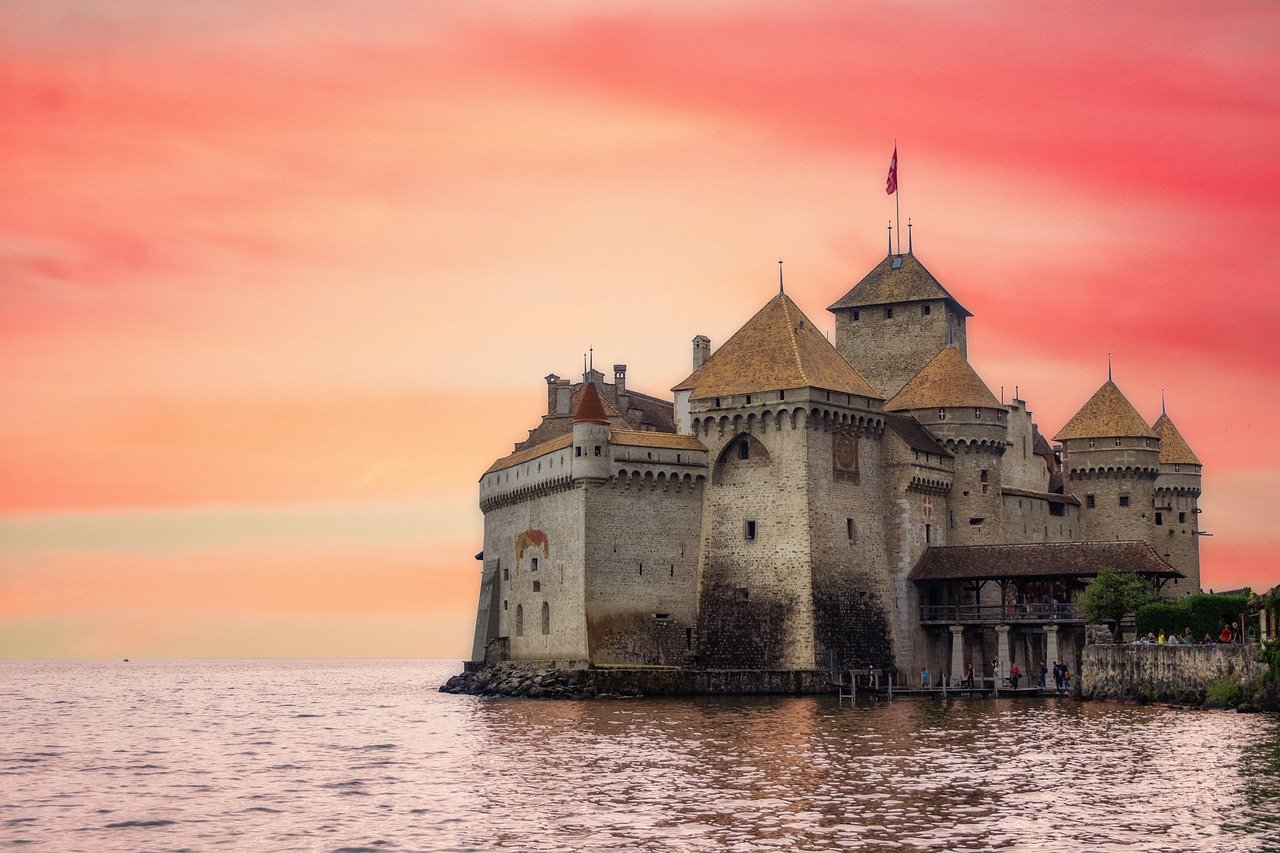
1. Château de Chillon (Chillon Castle) – Montreux
One of the most famous castles in Europe, Château de Chillon is an architectural marvel nestled on the shores of Lake Geneva. Dating back to the 12th century, this fortress has stood as a strategic stronghold, a royal residence, and a source of literary inspiration. Its medieval towers, grand halls, and underground vaults make it a must-visit site.
- Location: Veytaux, in the Vaud Canton
- Why Visit? Set on the edge of Lake Geneva, Château de Chillon is steeped in history. Its dramatic lakeside setting, well-preserved interiors, and centuries-old legends make it a must-see.
- Architectural Style: Medieval fortress with Romanesque and early Gothic elements
- How to Visit? Easily accessible by boat from Montreux or by local bus from nearby towns, the château offers guided tours and ample signage in multiple languages. Entrance tickets can be purchased online or at the gate.
- Insider Tips: Arrive early in the morning to or late afternoon to avoid crowds and take the lakeside walking path for spectacular views and photo opportunities. You can also jump on one of the ferries that travels across Lake Geneva and capture great photos from the water. Don’t miss the underground vaults featured in Lord Byron’s poem The Prisoner of Chillon.
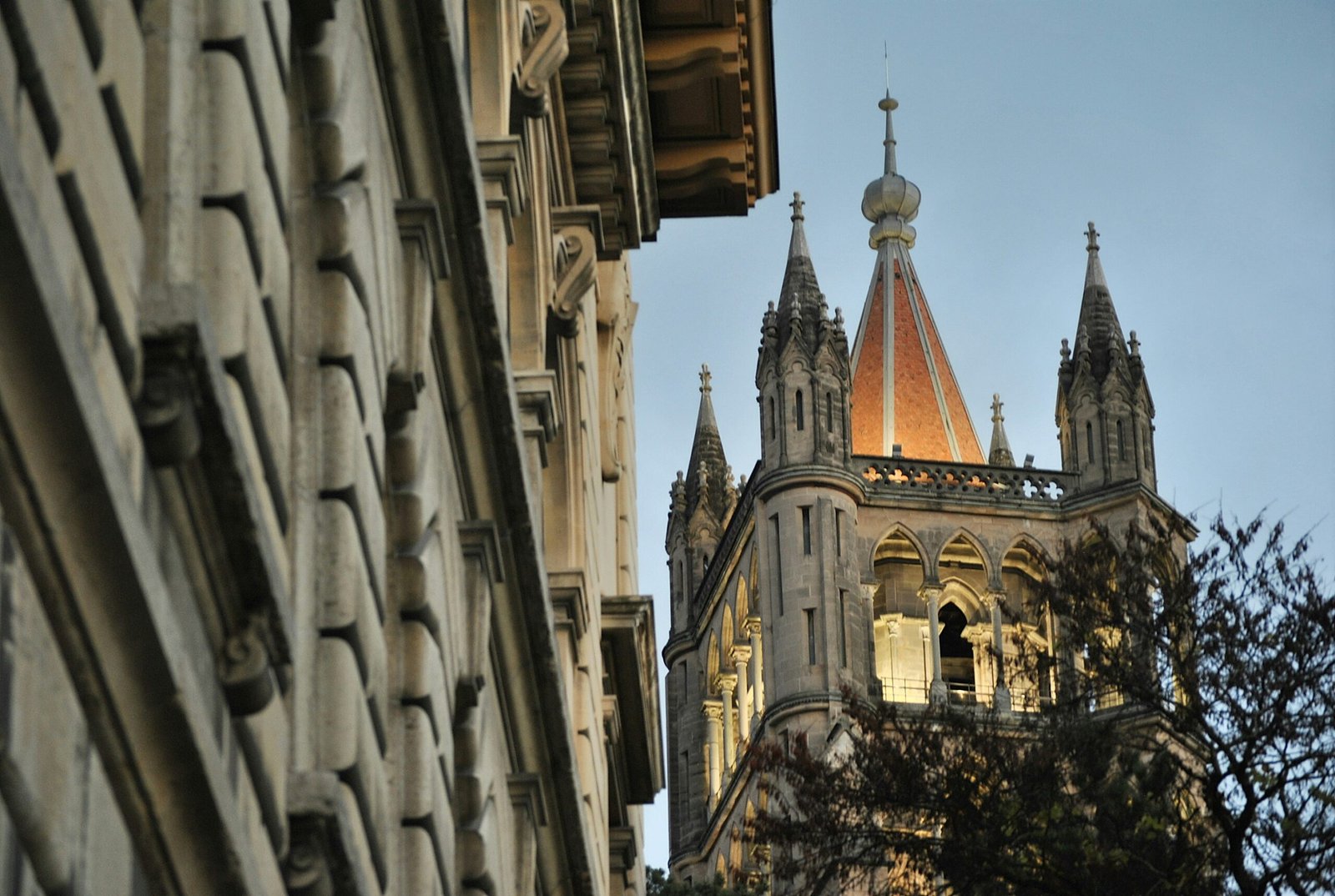
2. Notre-Dame Cathedral (Lausanne)
The Place de la Cathédrale, also known as Cathedral Square, holds immense historical significance for Lausanne. It’s home to the Cathedral of Notre Dame, a Gothic masterpiece that dates back to the 12th and 13th centuries. The cathedral is considered one of Europe’s most beautiful Gothic churches and has been designated a Swiss heritage site of national significance. In addition to its architectural beauty, it houses important works of art and history such as medieval frescoes, stained glass windows from different periods, and an impressive organ designed by renowned contemporary architect Bernard Aubertin.
- Location: Lausanne, Canton of Vaud
- Why Visit? Considered Switzerland’s finest Gothic church, dating back to the 13th century. Its rose window and grand organ are highlights.
- How to Visit: Free entry, guided tours available. Located in Lausanne’s Old Town.
- Insider Tips: No visit would be complete without climbing up La Tour de l’Horloge (The Clock Tower). This tower, which is part of the cathedral complex, offers panoramic views of Lausanne city and Lake Geneva. It’s a steep climb with about 200 steps but every step is worth it when you reach the top and witness the breathtaking view.
The organist at Lausanne Cathedral, Jean-Christophe Geiser, internationally celebrated, guarantees the cathedral numerous amazing performances, excellently playing the 7000 pipes – which make this organ a technological and musical masterpiece. More info here. When night falls, the Cathedral becomes more enchanted. A highlight is the night watchman’s traditon between 10pm and 2am, Alexandre Schmid stands at the top of the Cathedral’s bell tower and shouts out each hour to the residents. This role was historically meant to protect the city but it now remains to continue a 600 year-old tradition. A unique experience to inspire a late night stroll past this historical highlight!
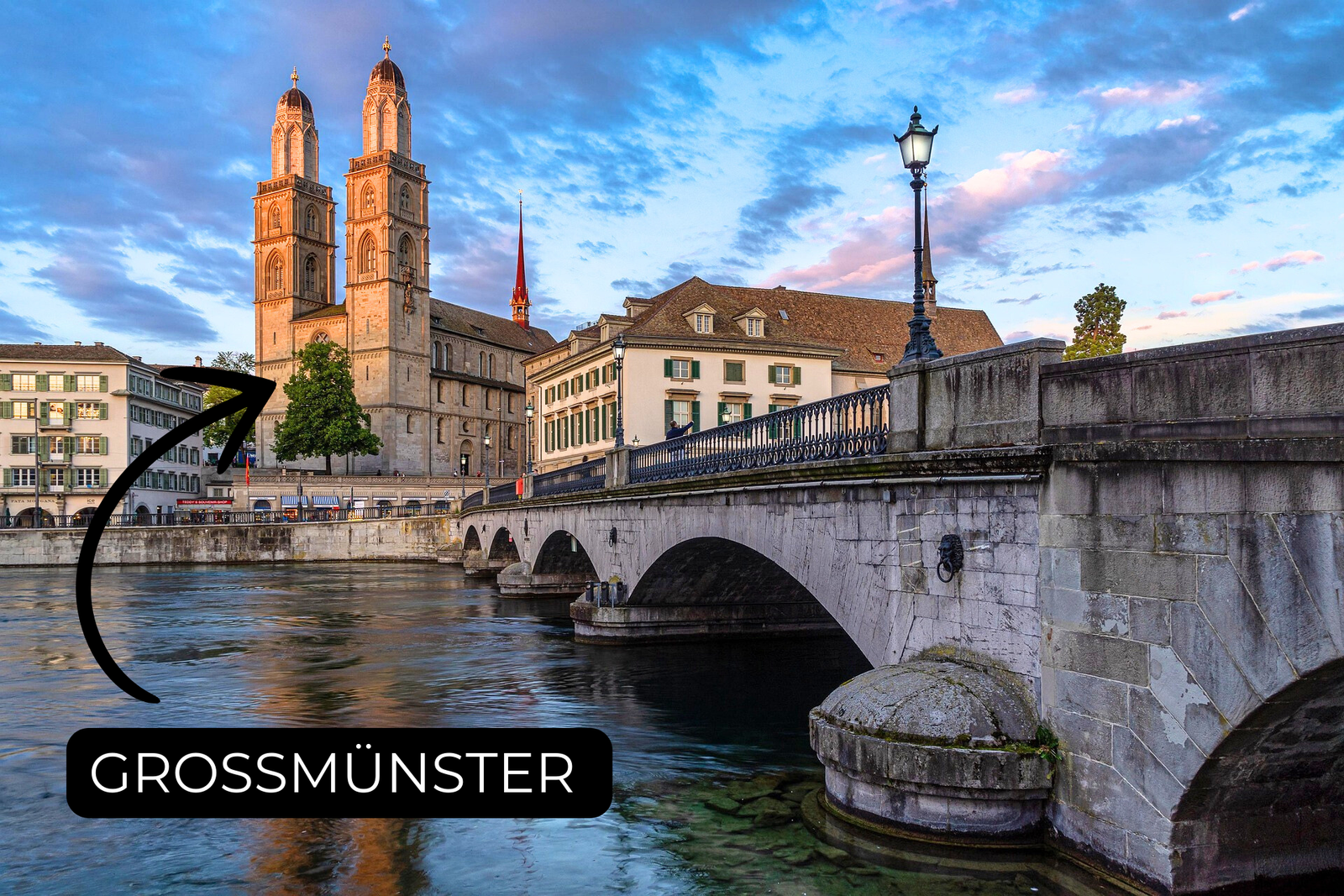
3. 2 churches – the Grossmünster and the fraumünster (Zurich)
In true efficient Swiss fashion, two of Zurich’s most iconic churches are planted conveniently across a charming foot bridge. This begs the question: If you have the time, why not visit them both? The Grossmünster, often used as the symbol of the city with its distinctive twin towers, dominates the city’s skyline. Romanesque origins gave way to later Gothic modifications, this historic church played a pivotal role in the Swiss Protestant Reformation and remains an architectural and historical highlight.
- Location: Zürich, Old Town
- Why Visit? An iconic twin-towered church central to Zürich’s skyline and Reformation history. Its storied past and panoramic views from the tower provide an unforgettable experience.
- Architectural Style: Romanesque with Gothic elements
- How to Visit? Located in the heart of Zurich’s Old Town, it’s an easy walk down Bahnhofstrasse from the main train station. The church entry is free and offers self-guided tours with informative plaques in multiple languages. Tower access requires a small fee, but totally worth it.
- Insider Tips: Climb one of the towers for views over Zurich, the Limmat River, and the Alps. Make sure to look for the Fraumünster across the bridge. Don’t forget your camera!
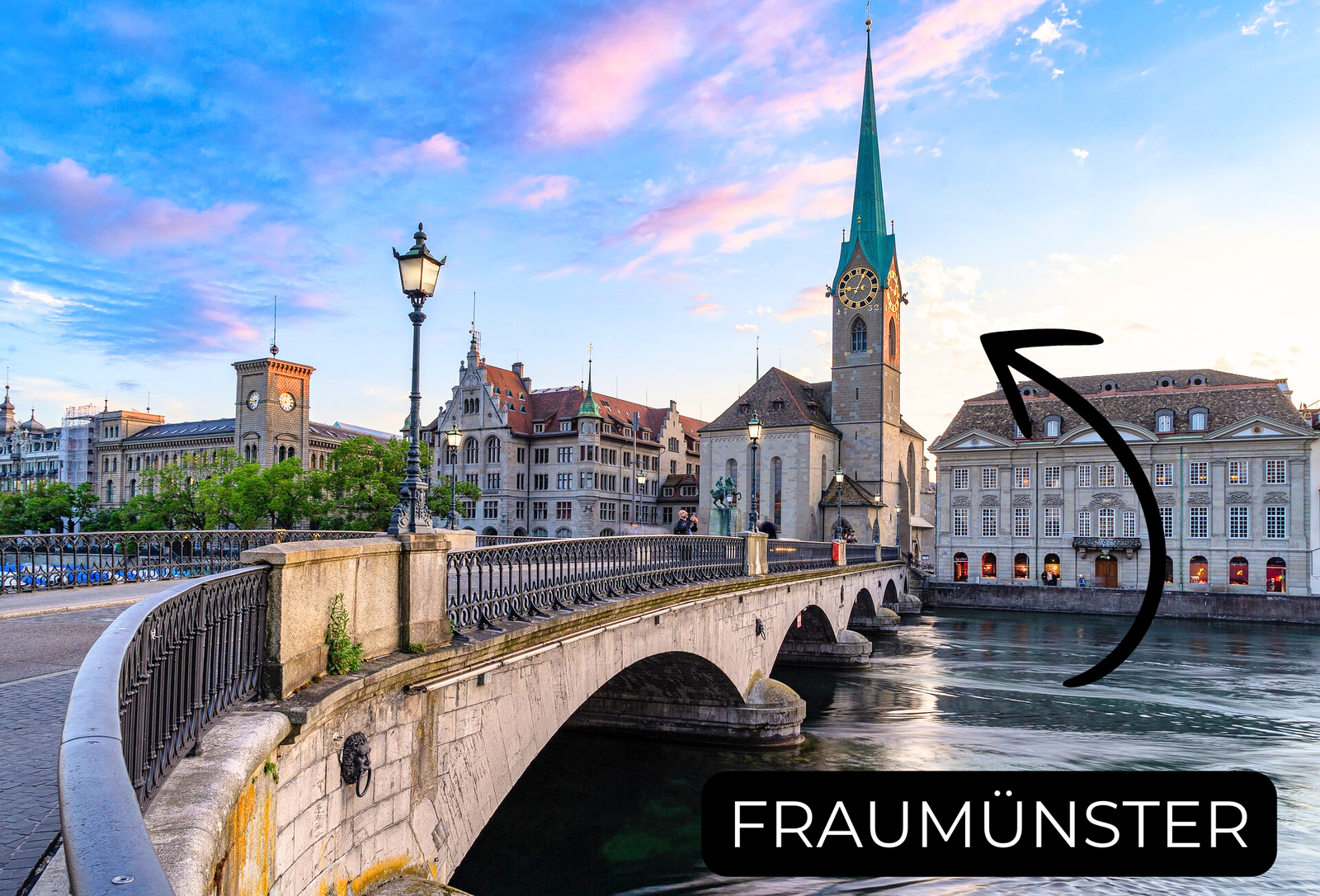
4. Fraumünster Church (Zurich)
Nestled across the Münsterbrücke (cathedral bridge) from the Grossmünster, stands another enchanting and culturally significant landmark, the Fraumünster Church. This smaller iconic church promises a memorable experience that bridges centuries of art, history, and spirituality.
- Location: Zürich, Old Town
- Why Visit? The Fraumünster Church is best known for its stunning stained glass windows, particularly those created by the renowned artist Marc Chagall. See the panels here. These luminous masterpieces infuse the church with a kaleidoscope of colors and serve as a symbol of Zürich’s vibrant artistic heritage. The windows, each telling a story through their intricate designs, invite visitors to pause, reflect, and marvel at the fusion of modern art with ancient spirituality.
- Architectural Style: Initially Romanesque with later Gothic renovations and modern art integrations.
- How to Visit? Located in the heart of Zürich’s old town, it’s a short walk from Zürich Hauptbahnhof. Free entry is available, with guided tours offered occasionally.
- Insider Tips: Visit during a quiet weekday afternoon to fully appreciate the artwork and history without the usual tourist bustle. A quieter visit means you can linger in front of the Chagall windows and soak in the peaceful atmosphere without interruption. If you’re an avid photographer, plan your visit to capture the windows at different times of the day when the light best accentuates the colors and patterns. A last note, Please Respect the Sacred Space! Remember that Fraumünster Church is a place of worship. While visitors are welcome, be mindful of the serene environment—keep noise levels down and follow any guidelines provided by the church, especially during religious services.

5. Kapellbrücke & Water Tower (Lucerne)
In the heart of Lucerne, the Kapellbrücke (Chapel Bridge) and its iconic Water Tower are two of Switzerland’s most photographed landmarks. With their rich history, enchanting architecture, and scenic riverside views, these timeless symbols of Lucerne are a must-visit for anyone exploring the city.
- Why Visit? The oldest wooden covered bridge in Europe, Kapellbrücke is a postcard-perfect landmark, with historical paintings decorating its interior.
Historical Charm:
Dating back to the 14th century, the Kapellbrücke is the world’s oldest wooden bridge, steeped in legends and stories of Lucerne’s past. The bridge’s interior is adorned with historic paintings that capture moments from the city’s history, making it a living museum of art and architecture.
Iconic Symbolism:
The adjacent Water Tower, once part of the city’s fortifications, has stood as a silent sentinel over Lucerne for centuries. Together, the bridge and tower encapsulate the blend of historical fortitude and natural beauty that characterizes the city.
Picturesque Scenery:
Walking along the Kapellbrücke offers breathtaking views of the Reuss River and the surrounding old town. Whether you’re an avid photographer or simply looking to soak in the atmosphere, the charm and romance of these structures provide endless opportunities for memorable moments.
- How to Visit? Right in the city center, just a short walk from Lucerne’s train station. Consider joining one of the guided walking tours available in Lucerne, which often include detailed narratives about the bridge’s history and the Water Tower’s role in the city’s defense.
- Insider Tip: Visit at sunrise or after dark for the most magical views without the tourist crowds.

6. St. Pierre Cathedral (GENEVA)
Saint-Pierre Cathedral is the most visited monument in Geneva. It welcomes around 400,000 people per year. Often referred to as the “Protestant Rome” and became in 1536 the adopted home church of John Calvin. You can even see his simple wooden chair – just don’t try to sit on it! After 157 steps, the view from the top of the towers is exceptional. It takes about an hour for a quick visit to the Cathedral, the Chapel of the Maccabees and the unique panoramic view from the towers, an hour for the Archaeological Site, and another hour for the Museum of the Reformation.
- Location: Geneva
- Why Visit? Dominating the Old Town of Geneva, St. Pierre Cathedral is steeped in religious history. A key site of the Protestant Reformation, this Gothic cathedral is famous for its archaeological underground site and panoramic views from the tower. Its crypt and historical artifacts add to its allure.
- Architectural Style: Predominantly Gothic, with Romanesque foundations
- How to Visit? A short walk from Geneva’s Old Town and the lakefront. The cathedral is open daily with guided tours available that uncover its rich past.
- Insider Tips: Don’t skip the underground archaeological site, showcasing remains from the 4th century!

7. Zytglogge (BERN)
First it was a fortified guard tower, then a prison, a lookout and fire observation tower, and finally a clock tower. Over the centuries, this landmark has fulfilled different functions for the city of Bern, but always a key protecter.
- Location: Bern
- Why Visit? This medieval clock tower is not just a timekeeper but a living piece of Bern’s history, complete with animated figures that charm visitors every hour. The mechanical figures, including a parade of bears, a jester, a golden rooster and Chronos, the god of time, each take a turn delighting hourly visitors.
- Architectural Style: Medieval Romanesque with intricate clockwork mechanisms.
- How to Visit? Located in Bern’s UNESCO-listed Old Town, it’s within easy walking distance from the main train station. Daily tours explain the fascinating history of its clock.
- Insider Tips: Time your visit to witness the hourly mechanical show – it’s a fun spectacle for all ages! Go inside and climb the 130 steps for a breathtaking view of the UNESCO World Heritage Site with its tiled roofs, terraces and narrow lanes. When the sky is clear, you can see all the way to the peaks of the Bernese Oberland.
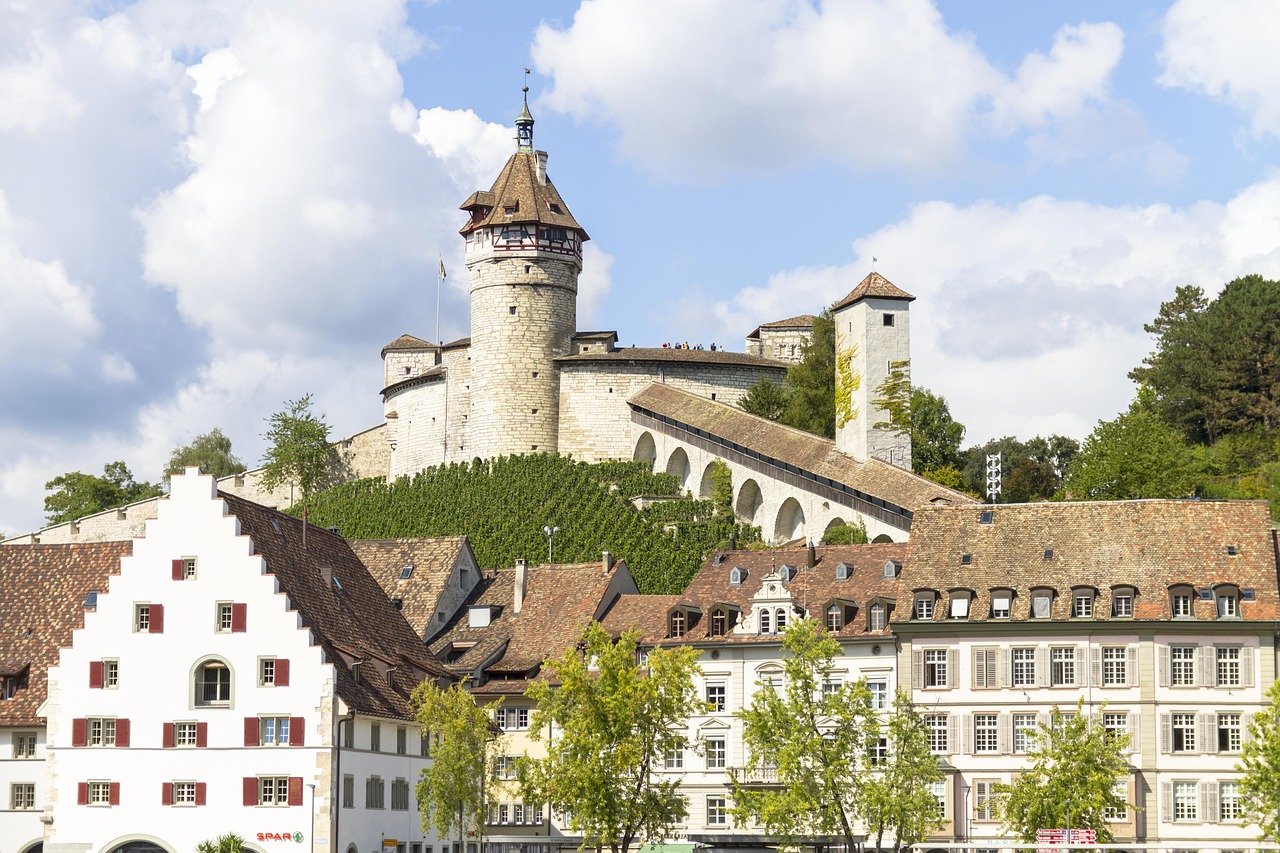
8. Munot Fortress (schaffhausen)
- Location: Schaffhausen
- Why Visit? Overlooking the charming town of Schaffhausen, the circular Munot Fortress offers panoramic views of vineyards along the German border and a glimpse into the region’s military past. It’s a favorite spot for both history lovers and families.
- Architectural Style: Renaissance fortress with classical military design
- How to Visit? Easily accessible by foot from Schaffhausen’s old town, guided tours are available during peak seasons.
- Insider Tips: Visit at sunset for stunning views over the town and the Rhine River, and explore the surrounding parklands and pack a picnic for a relaxed afternoon.

9. Rapperswil Castle (Zurich lake)
- Location: Rapperswil, St. Gallen Canton, on the southern edge of Zurichsee (Lake Zurich)
- Why Visit? To walk through a living postcard starring in your own romantic fairy tale come to life. If you’re in Zurich during “good weather”, I highly recommend saving a day to visit Rapperswil. Set in the “Town of Roses,” with over 20,000 blossoms annually, Rapperswil is a slice of mediterranean heaven on the shores of Lake Zurich. The Castle dates back around 1200 to 1220 AD, and was first mentioned in 1229 as the foundation of the Rüti Abbey. Perched on the hillside, the monks claimed the scenic views of Lake Zurich and the historic Old Town.
- Architectural Style: Medieval fortification with later Renaissance enhancements
- How to Visit? Easily reached by a scenic boat ride from Bürkliplatz in Zurich which lasts 2 hours. Also accessible by a 40m train ride. The castle is part of a picturesque riveria town that invites leisurely exploration.
- Insider Tips: Makes a great day trip from Zurich city. If pressed for time, take the boat over and ride the train back to town. Meandering through the alleys and strolling by the lake. Wander through the adjacent rose gardens blooming from May to October and stroll along the lakeside promenade and marina to soak in the mediterranean ambiance. Visit the municipial vineyards and the fields around the castle and count how many deer you can spot nibbling in the field. Learn more with this video.
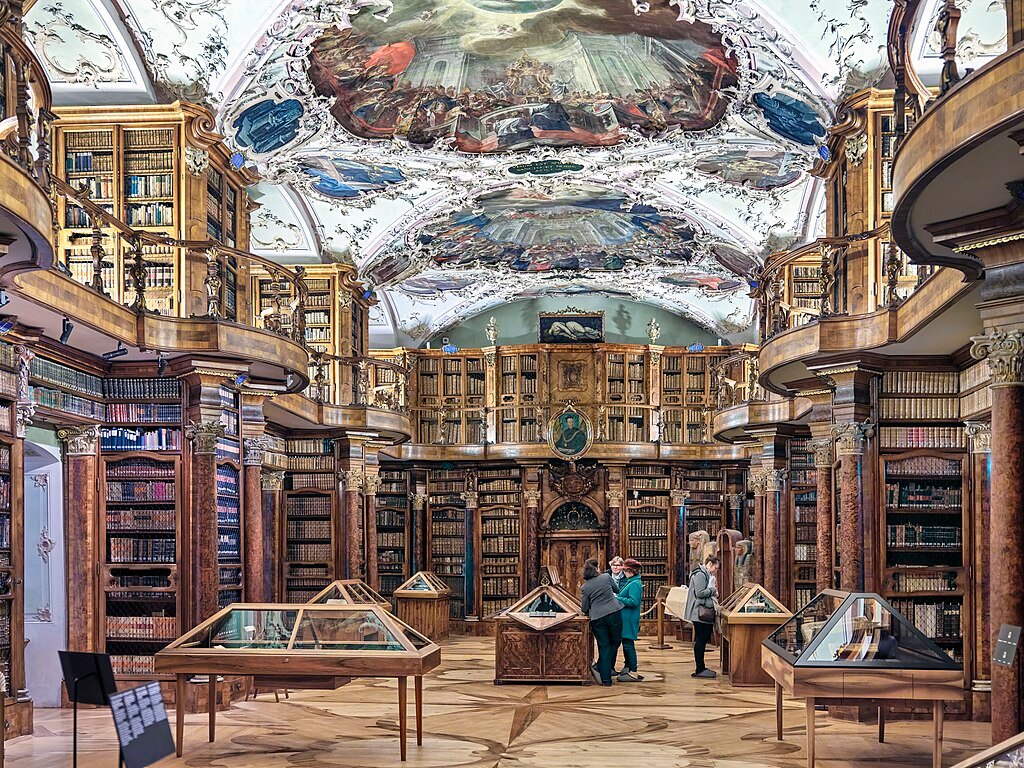
10. The Abbey of Saint Gall (St. Gallen)
A UNESCO World Heritage Site that represents 1200 years of history of monastic architecture and is a outstanding ensemble of a Benedictine convent. Almost all the important architectural periods, from the High Middle Ages on are incorporated. It began as a Carolingian monastery, from the 8th century to its secularization in 1805. Renovated and expanded in 1750s, theatrical Baroque architecture in the and one of the most significant monastic sites in Europe. Its library, one of the oldest and most beautiful in the world, holds a priceless collection of medieval manuscripts, making it an intellectual and architectural gem.
- Location: St. Gallen, St. Gallen Canton
- Why Visit? A UNESCO World Heritage site, featuring an ornate Baroque library with 170,000 ancient books. For its ruffled balconies, ornamental wooden carvings, and an awe-inspiring frescoes.
- Architectural Style: Primarily Baroque with earlier Romanesque influences
- How to Visit? Open daily, with guided tours in multiple languages. Located in St. Gallen, easily reachable by train or car. Guided tours provide deep insights into its storied past and architectural evolution.
- Insider Tips: Don’t miss the stunning Rococo library – photography is restricted there, but the beauty is unforgettable, so take the time to absorb its beauty in person. Click here to see more of the library. If possible, plan your visit during a cultural festival or exhibition at the abbey to experience its history alongside contemporary Swiss art and music.

11. 3 Castles – Castelgrande (Bellinzona)
- Location & Canton: Bellinzona, Ticino Canton
- Why Visit? As part of Bellinzona’s trio of UNESCO-listed castles, Castelgrande is a stellar example of medieval military architecture, offering insights into Switzerland’s defensive history. One of three castles connected by a tourist train, the Artù train, which is active from April to November, is akin to a journey back in time.
- Architectural Style: Medieval fortress with strategic military design – the only of its kind in the alpine region.
- How to Visit? Accessible via train to Bellinzona and then a short walk uphill, the castle offers self-guided tours and informative displays in several languages.
- Insider Tips: Combine your visit with a tour of the other two castles in Bellinzona: Montebello and Sasso Corbaro for a comprehensive historical journey. If you can, plan your trip to Bellinzona on a Saturday, market day and enjoy the lively walk through the historic center.
The museum is spread across two floors in the southern wing of Castelgrande, the ducal fortress restored by architect Aurelio Galfetti from 1980 to 1991. The archaeological section offers a brief presentation of the 6,500 years of human presence on the hill, from the first Neolithic village to the twentieth century, ending with an entertaining film. Don’t miss the collection of fifteenth century coins, bearing witness to the mint used by the three primitive cantons. Meanwhile, the art history section includes a series of tempera paintings on paper (ca. 1470) which originally decorated the wooden ceiling of a lavish fourteenth century residence in the city centre that was demolished in 1970.

12. Castello di Montebello (Bellinzona)
🏰 Why Visit? One of Ticino’s three UNESCO-listed castles, Montebello offers medieval charm, stunning views, and an immersive look into Swiss-Italian history.
📍 How to Visit? A short uphill walk from Bellinzona’s train station.
💡 Tip: Visit all three Bellinzona castles with a combined ticket for a full medieval experience!
Perched majestically over Bellinzona, the Castello di Montebello invites travelers to step back in time and immerse themselves in medieval history while enjoying breathtaking views of the surrounding Swiss landscapes. Accessible via a short local bus ride from the city center followed by a gentle hike up to the castle, reaching this historical gem is as delightful as the experience itself. Insider tips include arriving early in the day to dodge the midday crowds, taking advantage of the detailed guided tours available on site to truly understand the castle’s storied past, and bringing a light picnic to savor in the tranquil outdoor spaces. Whether you’re a history buff or simply looking to add a unique adventure to your Swiss itinerary, the Castello di Montebello promises an enriching and picturesque escape.
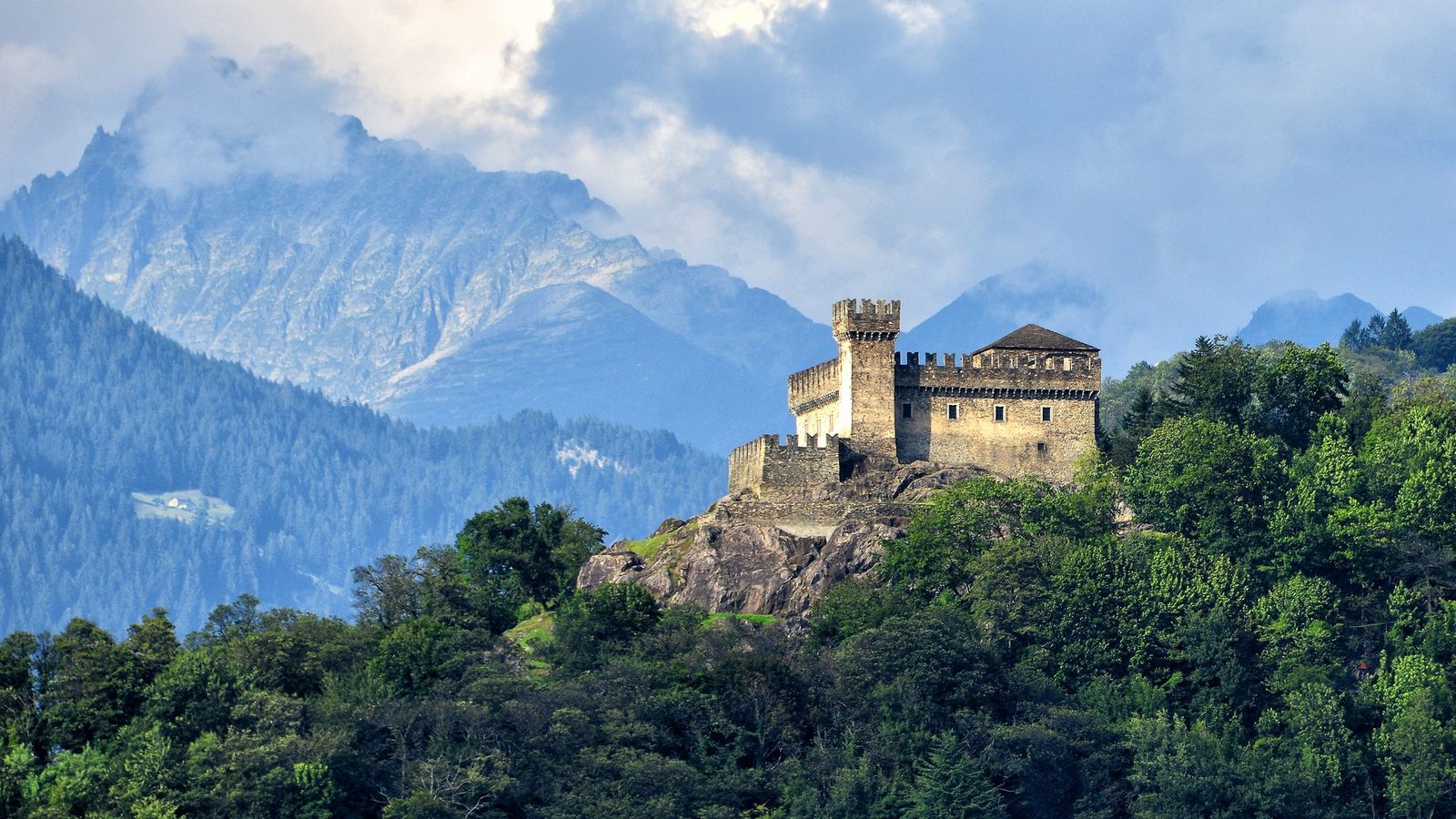
13. castello sasso corbaro (Bellinzona)
Perched on a hilltop overlooking the charming town of Bellinzona, Castello Casso Corbaro is the third in the trifecta of local military fortifications and a must-visit for history buffs and nature lovers alike.
- Why Visit: This medieval fortress offers a unique glimpse into Switzerland’s storied past, complete with rugged stone walls and panoramic views that capture the essence of the Swiss landscape.
- How to Visit: To get there, you can easily hop on a local bus or drive from Bellinzona’s well-connected transport hub, followed by a scenic, short hike up the gentle trail that winds its way to the castle—an adventure that’s as rewarding as the destination itself.
- Insider tip: For making the most of your visit include arriving early in the morning to enjoy the tranquil atmosphere and avoid the crowds, joining a guided tour for fascinating historical insights, and bringing a picnic to savor amidst the castle’s serene surroundings. Whether you’re a keen history enthusiast or simply in search of a picturesque escape, Castello Casso Corbaro promises an enriching and unforgettable Swiss experience.

14. Gruyères Castle (Fribourg)
- Location & Canton: Gruyères, Fribourg Canton
- Why Visit? Nestled in the picturesque medieval town of Gruyères, this castle not only tells tales of feudal times but also provides sweeping views of the surrounding countryside.
- Architectural Style: Medieval with Renaissance touches
- How to Visit? Reachable by a combination of train and local bus from major cities like Bern or Lausanne, the castle is well-signposted and offers guided tours during the summer months.
- Insider Tips: After exploring the castle, don’t miss a taste of the local cheese and chocolate – a true Gruyères specialty!

15. Basel Minster (basel)
- Location & Canton: Basel, Basel-Stadt Canton
- Why Visit? Dominating the Basel skyline, this cathedral is an architectural marvel, combining Romanesque foundations with Gothic splendor. Its towers offer panoramic views of the Rhine and the city below.
- Architectural Style: A harmonious blend of Romanesque and Gothic styles
- How to Visit? Located in Basel’s historic old town, the Minster is a short walk from the main train station. Regular guided tours and audio guides enrich the visitor experience.
- Insider Tips: Climb the towers at sunrise for a breathtaking view over Basel’s rooftops and the flowing Rhine – a photographer’s dream!
Switzerland’s historic buildings are not just relics of the past – they are living stories that invite you to explore the nation’s rich cultural tapestry. Whether you’re wandering along cobbled streets in medieval towns or marveling at centuries-old fortresses perched atop serene lakes, each building offers a unique insight into Swiss heritage. Pack your bags, plan your itinerary, and get ready to step back in time on a truly unforgettable holiday!






Leave a Reply